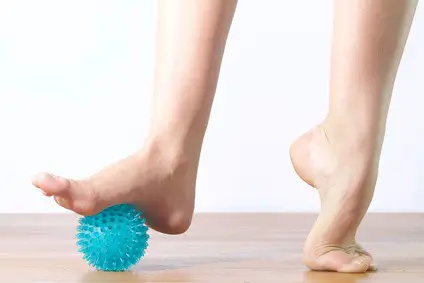If you have a bit of foot pain recently and can feel a small nodule on the sole of your feet which may be painful to touch, then you might have a specific problem that affects a lot of people at some point in their lives know as Plantar Fibroma or Knot in Arch of Foot.
What is plantar fibroma?
A plantar fibroma is a painful knot on the bottom of the foot, that’s caused by a benign nodule. It develops within the plantar fascia which is a thick, fibrous tissue that runs from your heel to your toes and stabilizes your foot arch.
Slow growing, most plantar fibroma measure less than an inch in size, and tend to appear in later life, with an increasing chance as you age. It should be differentiated from Plantar Fibromatosis which is a very rare and more severe disease with multiple large-sized nodules covering the sole of the feet.
No one knows exactly what causes plantar fibroma, but damage and trauma to the area are not a factor, so the current hypothesis is that the main cause is genetic.
What are the symptoms of a plantar fibroma?
A plantar fibroma is easily recognized by the solid lump of flesh that can be felt in the middle of the arch of the foot, normally around halfway between the heel pad and footpad.
Over time, this mass can increase in size, or more than one can occur. Instances of Plantar fibroma may or may not be painful, but when they are painful, they are generally recognized by pain in foot arches when walking, or when placed under pressure, ie, when you press on it.
Will Plantar fibroma become a Cancer?
No. Plantar fibroma is a non-cancerous mass and apart from the pain and inconvenience, causes no long-term harm.
How do you treat a plantar fibroma?
Whilst some knots in the arch of your feet will have no effect on your ability to live your life, sometimes a plantar fibroma can have long-term issues.
If you’ve got a bad plantar fibroma that causes you debilitating pain in arch of foot when walking or otherwise, then it may require treatment.
Available Treatment Options for Plantar Fibroma include;
Steroid injections
A Steroid injection (not the same as Steroids for bodybuilders) is a strong anti-inflammatory medication. steroid injections can cause short-term shrinkage of the mass and a reduction in short-term pain. However, it has also been shown to have little to no longer-term effects on either pain or growth.
So even though the steroids are effective in relieving any inflammatory process, the nodule may continue to grow.
Orthotics
Orthotics generally refers to the use of therapeutic footwear or insoles that offset the pressure on your foot. They are seen to be beneficial if the plantar fibroma is small and hasn’t changed in size over some time. Orthotic devices such as gel or foam pads and insoles work by redistributing the body weight and relieving the associated pain.
Although their long term effects can be debated, they do provide relief in a lot of reported cases and are easily affordable.
You can purchase orthotics online.
Physical therapy
Physical therapy helps break tissue accumulation in the foot. Your physical therapist will help you develop a routine of strength training and stretching exercises that can help increase blood circulation and stimulate cell growth. Increased circulation can also reduce inflammation and relieve pain caused by a knot in foot arch. There are no published studies that show that physical therapy has a significant beneficial effect in the treatment of these painful knots, however.
Surgery
In severe cases, If physical treatment is ineffective, the next step is generally surgery.
Surgery is usually considered if the fibroma continues to cause pain after all non-surgical means have been exhausted. Surgical intervention for a knot in arch of foot tends to be relatively minor. As with all foot and leg surgery, expect to be off your feet for a time, but surgery of this sort tends to only require around a week or two of recovery time if you can get adequate rest and recuperation.
All things going well, you should be completely healed and back to full strength in around a month, potentially two.
Are there possible complications with fibroma surgery?
As with other surgical procedures, there are few side effects that can happen following surgery to remove the knot in arch of foot.
In general, you may face a wound that becomes infected or requires fluid drainage. The procedure can cause your foot arch to become flattened and increase your risk of hammertoe and flat feet. You may also find chronic or returning pain or in worst cases the return of the mass after foot surgery.
If you are worried about any of these potential complications, make sure you talk it over with your practitioner.
Is there any home remedy for knot in arch of foot?
Unfortunately not. Whilst massage can help foot recovery and revitalize tired feet, it does nothing to deal with the cause of the problem.
If you find massage helps, by all means, massage your foot, but be aware that you can’t break down that painful knot in arch of foot with physical therapy.
If you’ve recently found a lump in the arch of your foot, or if you’ve been dealing with plantar fibroma for a while, the best thing to do is speak to your doctor. They will be able to give you treatments based on your specific circumstances.

